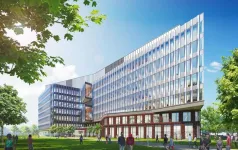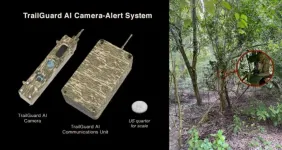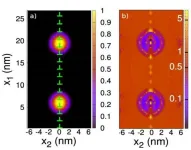(Press-News.org) HOUSTON ― The University of Texas MD Anderson Cancer Center today broke ground on a 600,000-square-foot facility intended to anchor the institution’s expansive south campus research park. The building was purposefully built to enable collaborative science and impactful breakthrough discoveries that will accelerate efforts to end cancer.
A $668 million institutional investment will support the construction of MD Anderson’s South Campus Research Building 5 (SCRB5), a 7-story building designed by Elkus Manfredi Architects with state-of-the-art research facilities and inspiring public spaces to facilitate exceptional science. The facility, including a landscaped park conceived by Mikyoung Kim Design, is expected to be completed in the spring of 2026.
“The construction of our visionary new research building marks the beginning of our next chapter in Making Cancer History®,” said Peter WT Pisters, M.D., president of MD Anderson. “With input from hundreds of MD Anderson teammates, we have carefully designed this building and our research campus to foster collaboration, to stimulate creativity and to fuel breakthroughs that will improve the lives of patients here and around the globe.”
Located at 1920 Old Spanish Trail, SCRB5 will bring together MD Anderson scientists and researchers into one dynamic space to collectively share and advance their work. The new facility, an extension of the Texas Medical Center’s (TMC’s) Helix Park, will serve as a hub for collaboration across MD Anderson as well as the entire TMC.
“This investment highlights our commitment to leading the world in cancer research, and I am proud to offer our talented researchers and future recruits the world’s finest facilities, environment, tools and technologies to support exceptional, high-impact science,” said Giulio Draetta, M.D., Ph.D., chief scientific officer at MD Anderson. “Our research environment fosters a culture of collaboration, connectivity and data-based science only possible here, and this new research facility will further enhance new and exciting opportunities across our community.”
The institution’s unique research ecosystem is marked by seamless collaboration between scientists and clinicians, creating a virtuous cycle of breakthroughs. Discoveries from the lab fuel new efforts in the clinic, while insights from the clinic likewise inform research at the bench in real time.
Innovative in both design and function, SCRB5 will feature flexible research areas as well as expansive core facilities, all incorporating the latest technologies to enable groundbreaking research. The building will be home to a number of MD Anderson’s strategic research programs, including the James P. Allison Institute.
Public spaces will include a restaurant, a conference center and different lecture environments. Collaboration is woven into all areas of the building, with places for scheduled discussions and unplanned exchanges throughout.
“Our research campus will serve as a collaborative hub of premier cancer research around the world, gathering thousands of the top minds in the field into one block, all focused on a singular mission to end cancer,” said Philip Jones, Ph.D., vice president of Research Strategy and Operations at MD Anderson. “We’re pleased to witness the next step in our journey, and we look forward to the innovative ideas and groundbreaking discoveries that will come from this beautiful, dynamic space.”
Beyond the scientific facilities, the building also is designed to maximize sustainability and efficiency while optimizing the experience of those working within. The surrounding green spaces, connecting pathways, gathering spots and places for reflection and inspiration will set a new standard for other research institutions across the country.
As a leader in cancer research, MD Anderson is committed to supporting high-impact research across the spectrum of cancer science, including discovery, prevention, translational and clinical research. In the last fiscal year, MD Anderson invested $1.1 billion on research and had more projects funded by the National Cancer Institute than any other U.S. institution.
Understanding the importance of exceptional research as a driving force behind progress in its mission to end cancer, MD Anderson is proud to support World Cancer Research Day, Sept. 24., which calls for global efforts to promote cancer research in order to reduce the burden of this disease.
Read this press release in the MD Anderson Newsroom.
- 30 -
END
Researchers from Ann & Robert H. Lurie Children’s Hospital of Chicago and colleagues reported for the first time that a genetic biomarker may be able to help predict the severity of food allergy reactions. Currently there is no reliable or readily available clinical biomarker that accurately distinguishes patients with food allergies who are at risk for severe life-threatening reactions versus more mild symptoms. Findings were published in the Journal of Allergy and Clinical Immunology.
Dr. Lang and colleagues found that the presence of an enzyme isoform called α-tryptase, ...
For decades, wildlife biologists have dreamt of a “smart” camera alerting system capable of detecting tigers and other endangered species on the prowl. Legacy camera-trap technology, while valuable for many research applications, has historically been hindered by false positives and an inability to facilitate rapid responses.
Writing in BioScience, Jeremy Dertien of Clemson University and colleagues announce that for the first time ever, wild tigers and elephants have been detected by an artificial intelligence (AI)-powered, cryptic camera-alert system, TrailGuard AI, that transmits images to the ...
The first use of a novel method of analyzing Mars’ gravitational force supports the idea that the planet once had an extensive northern ocean.
In doing so, the method defines the scope of what scientists refer to as the northern Martian paleo-ocean in more detail.
The work was published in July in the journal Icarus, which is affiliated with the American Astronomical Society’s Division for Planetary Sciences.
The research was led by Jaroslav Klokočník, professor emeritus at the Astronomical Institute of the Czech Academy of Sciences. Gunther ...
Researchers have developed a method of “wiring up” graphene nanoribbons (GNRs), a class of one-dimensional materials that are of interest in the scaling of microelectronic devices. Using a direct-write scanning tunneling microscopy (STM) based process, the nanometer-scale metal contacts were fabricated on individual GNRs and could control the electronic character of the GNRs. The researchers say that this is the first demonstration of making metal contacts to specific GNRs with certainty and that those contacts induce device functionality needed for transistor function.
The results of this research, led by electrical and computer engineering (ECE) professor Joseph Lyding, along ...
A new type of regulation is needed to support and encourage organisations to comply with equality and human rights law because enforcement alone is ineffective, a new study says.
The introduction of the Public Sector Equality Duty and the Human Rights Act were intended to establish an equality and human rights culture within public authorities. The research highlights how this culture has failed to take hold.
An alternative is needed to the current model of regulation (the enforcement pyramid) under which penalties increasingly progress until noncompliers comply. The study says the current model cannot recognise innovation, ...
Materials are often considered to be one phase, but many engineering materials contain two or more phases, improving their properties and performance. These two-phase materials have inclusions, called precipitates, embedded in the microstructure. Alloys, a combination of two or more types of metals, are used in many applications, like turbines for jet engines and light-weight alloys for automotive applications, because they have very good mechanical properties due to those embedded precipitates. The average precipitate size, however, tends to increase ...
Using a novel deep brain stimulation (DBS) device capable of recording brain signals, researchers have identified a pattern of brain activity or “biomarker” related to clinical signs of recovery from treatment-resistant depression. The findings from this small study are an important step towards using brain data to understand a patient’s response to DBS treatment. The study was published in Nature and supported by the National Institutes of Health’s Brain Research Through Advancing ...
The Eunice Kennedy Shriver National Institute of Child Health and Human Development awarded $3.1 million to the University of Arkansas to study a spectrum of pediatric mitochondrial disorders caused by mutations in the mitochondria. These disorders often impact different organs requiring energy and can lead to mitochondria-induced multiple organ disorder syndromes, or MIMODS.
Shilpa Iyer, an associate professor of biological sciences, will serve as the principal investigator on the five-year award. Iyer and her team conduct research on mitochondrial diseases and have received grants from Arkansas ...
Craniosynostosis, the premature fusion of the top of the skull in infants, is caused by an abnormal excess of a previously unknown type of bone-forming stem cell, according to a preclinical study led by researchers at Weill Cornell Medicine.
Craniosynostosis arises from one of several possible gene mutations, and occurs in about one in 2,500 babies. By constricting brain growth, it can lead to abnormal brain development if not corrected surgically. In complex cases, multiple surgeries are needed.
In the study, which appears Sept. 20 in Nature, the researchers examined in detail what happens in the skull of mice with one of the most common mutations found in human ...
SEPTEMBER 20, 2023, NEW YORK – In exploring an aspect of how killer T cells generate the raw materials required for their proliferation, a Ludwig Cancer Research study has uncovered an unexpected link between the immune cells’ metabolism, regulation of gene expression, persistence and functional efficacy that could be exploited using existing drugs to improve cancer immunotherapy.
Researchers led by Ludwig Lausanne’s Alison Jaccard and Ping-Chih Ho along with their University of Lausanne colleagues Mathias Wenes and Pedro Romero were exploring how proliferating T cells in the low-oxygen environment of tumors make citrate, a molecule essential to manufacturing membranes, which ...






